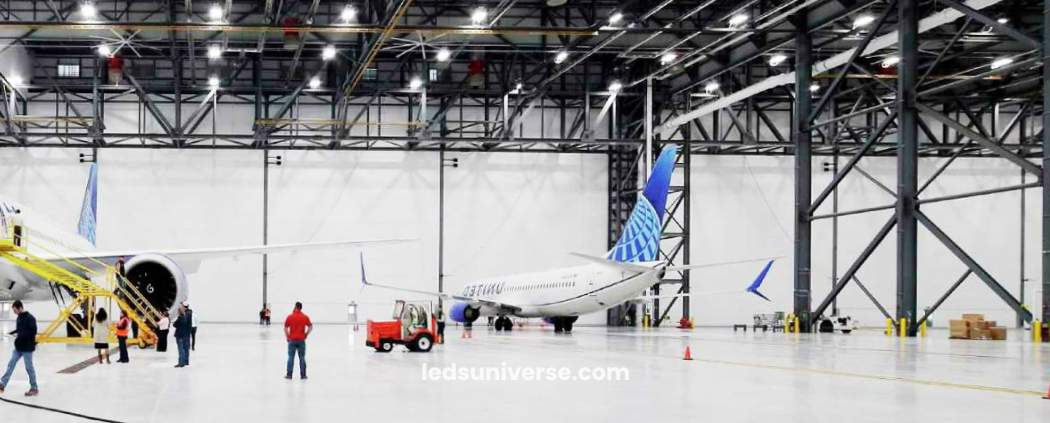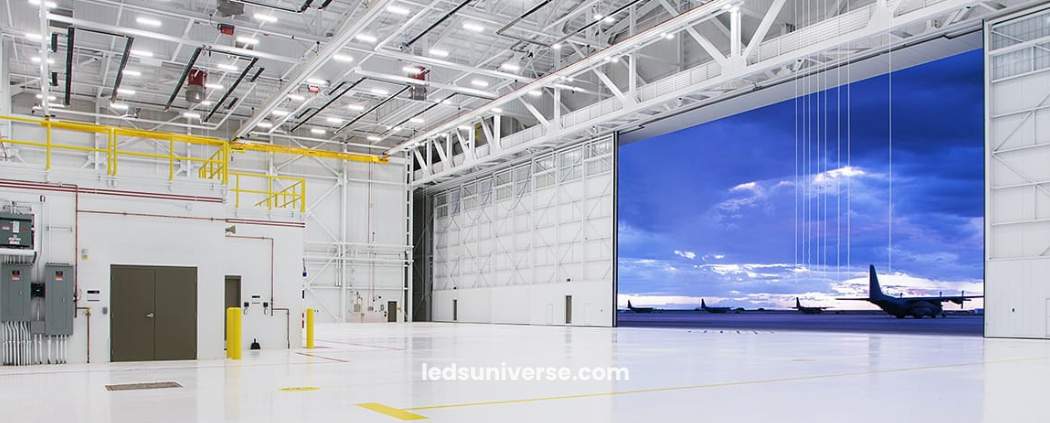Planning an LED lighting retrofit for an aircraft hangar? Start by thinking about the hangar’s size and ceiling height—bigger spaces need more lights and specialized fixtures. Next, the type of LEDs you choose can affect both upfront costs and long-term energy savings. Finally, consider the installation complexity—existing wiring might simplify things, but high ceilings and special equipment can increase labor costs. By balancing these factors, you can optimize your budget and maximize savings over time. Ready to explore how each decision impacts your project? Let’s get started!
Aircraft hangars, known for their expansive spaces and high ceilings, present unique challenges when it comes to lighting. The transition from traditional lighting systems such as metal halides or fluorescent fixtures to energy-efficient LED lighting can offer significant long-term savings, improved light quality, and a better working environment. However, understanding the costs involved in a retrofit and how to plan for them is crucial for efficient budgeting.
Reach out for free lighting consultation
Table of Contents
ToggleTo provide a clearer understanding of how the total cost of an LED lighting retrofit is distributed, it is helpful to break down the expenses into distinct categories. These categories include the cost of fixtures, labor, energy savings, and maintenance. The following sections provide estimates and a detailed analysis of each cost component.
| Cost Category | Estimated Range |
|---|---|
| LED Fixtures | $15,000 – $50,000 |
| Labor | $7,000 – $36,000 |
| Energy Savings (annual) | $25,000 – $40,000 |
| Maintenance Savings | $5,000 – $10,000 |
| Total Initial Costs | $22,000 – $86,000 |
The cost of LED fixtures varies based on their type, quality, and features. High-bay LED fixtures, commonly used in aircraft hangars, typically range in price from $150 to $500 per fixture, depending on factors such as wattage, lumens, and smart controls. For a medium-sized hangar requiring around 100 fixtures, the total cost for fixtures alone could range from $15,000 to $50,000.
Labor costs for installation depend on the complexity of the retrofit and the local rates for electrical contractors. On average, labor rates can range from $70 to $120 per hour. For a typical hangar retrofit project, the installation process could take anywhere from 100 to 300 hours, depending on the size of the hangar and the level of difficulty involved. This results in labor costs between $7,000 and $36,000.
One of the significant advantages of LED lighting retrofits is the reduction in energy consumption. LEDs consume up to 70% less energy than traditional lighting systems. In a hangar that operates its lighting for 12 to 16 hours a day, this can translate into substantial cost savings. For example, if a hangar previously consumed 50,000 kWh per month with traditional lighting and switches to an LED system that uses only 15,000 kWh, the energy savings could amount to $35,000 annually, assuming an electricity rate of $0.10 per kWh.
Traditional lighting systems, such as metal halide or fluorescent bulbs, require frequent replacements due to shorter lifespans, which adds to maintenance costs. LEDs, on the other hand, can last up to 100,000 hours, dramatically reducing the frequency of replacements. This longevity not only lowers maintenance costs but also minimizes disruptions to operations. Annual maintenance savings from switching to LED lighting can be in the range of $5,000 to $10,000, depending on the size of the facility and previous maintenance schedules.

Several variables influence the total cost of an LED lighting retrofit in aircraft hangars. These factors range from the size and layout of the hangar to the type of LED fixtures chosen and the complexity of the installation process. Understanding these factors allows facility managers and business owners to create accurate budget projections and manage their financial expectations for the project.
The size of the aircraft hangar directly impacts the number of fixtures required for adequate lighting coverage. Larger hangars will need more LED lights, leading to a higher initial purchase cost. In addition, the height of the ceiling affects the type of LED fixture required. High-ceiling environments necessitate high-bay LED fixtures, which are specifically designed for large spaces and provide bright, even illumination over vast areas. The higher the ceiling, the more powerful and efficient the light fixture needs to be, which can increase both the upfront costs and installation expenses.

Not all LED fixtures are the same. Different types of fixtures vary in quality, lumen output, energy consumption, and lifespan. Choosing high-quality LEDs with superior materials and technology, such as advanced heat management systems, can reduce long-term operational costs but may involve a higher upfront investment. Additionally, features like dimming capabilities, smart controls, and daylight sensors can enhance energy savings, though they may also increase the initial installation cost.
The energy efficiency of LED fixtures is measured in lumens per watt (lm/W). LEDs with a higher lm/W rating produce more light per unit of energy consumed. Although more energy-efficient fixtures may have a higher purchase price, they can result in substantial energy savings over time. For aircraft hangars, where the lights are often required to operate for extended periods, this energy efficiency can translate into lower utility bills, reducing the total cost of ownership over the life of the fixtures.
The complexity of installation can greatly impact the total cost of a retrofit. If the existing wiring and fixtures are compatible with LED systems, the installation process is simplified, lowering labor costs. However, if significant electrical upgrades or modifications to the existing infrastructure are needed, such as replacing ballasts or adding new circuitry, installation costs can rise. The need for specialized equipment, such as lifts or scaffolding, to reach high ceilings also adds to the labor expense.
Maintenance costs for LED lighting are significantly lower compared to traditional lighting systems, as LEDs have longer lifespans and are more durable. However, access to high-mounted fixtures in aircraft hangars can be challenging, necessitating the use of specialized equipment for installation and maintenance. Planning for these logistical challenges in advance can help ensure that installation proceeds efficiently without unexpected delays or cost increases.
Upgrading to LED lighting in aircraft hangars offers a wide range of benefits beyond cost savings. These advantages include better light quality, reduced environmental impact, and improved safety and productivity for workers. These benefits make LED retrofits an attractive option for hangar operators seeking to enhance both operational efficiency and lighting performance.
One of the most notable advantages of LED lighting is its ability to significantly reduce energy consumption. Traditional lighting systems, such as metal halide or fluorescent bulbs, are inefficient, with much of the energy consumed being wasted as heat. LEDs, by contrast, convert a much higher percentage of electricity into light, allowing for substantial energy savings. This improved energy efficiency results in lower operating costs, especially in hangars that require lighting for long hours.
Additionally, many LED systems are compatible with smart controls, such as motion sensors and daylight harvesting technologies. These features allow for more precise control over lighting usage, further reducing energy consumption by ensuring that lights are only in use when needed.
LED fixtures provide superior lighting quality compared to older systems. The light emitted by LEDs is closer to natural daylight, which helps reduce eye strain and improves visibility. This is particularly beneficial in aircraft hangars, where workers often engage in detailed tasks such as inspections and repairs. Proper lighting can improve both accuracy and productivity in these environments.
In addition, LEDs offer greater flexibility in terms of color temperature and brightness levels, allowing facility managers to customize lighting according to the specific needs of the space. Dimmable LED fixtures provide additional versatility, enabling the adjustment of light intensity based on activity levels within the hangar.
The long lifespan of LED lighting systems is another significant advantage. While traditional lighting systems typically last between 10,000 and 20,000 hours, LED fixtures can last up to 100,000 hours, greatly extending the time between replacements. This longevity reduces the need for frequent maintenance, lowering maintenance costs and minimizing disruptions to operations. In an environment like an aircraft hangar, where access to lighting fixtures can be challenging due to high ceilings, this reduction in maintenance is particularly valuable.
Proper lighting is crucial for maintaining safety in industrial environments like aircraft hangars. LED lighting provides consistent, uniform illumination with minimal glare or flicker, reducing the risk of accidents caused by poor visibility. This is especially important in areas where workers are operating heavy machinery, handling sensitive equipment, or performing detailed inspections on aircraft. Enhanced lighting quality can improve focus and reduce fatigue, contributing to a safer and more productive work environment.
Switching to LED lighting can also reduce the environmental footprint of an aircraft hangar. LEDs are far more energy-efficient than traditional lighting systems, meaning they consume less electricity and reduce the demand on power plants. Additionally, because LEDs last significantly longer, they produce less waste in terms of discarded bulbs and materials. Many LED fixtures are also free of hazardous materials like mercury, making them safer for the environment and easier to dispose of responsibly.
Budgeting for an LED lighting retrofit in aircraft hangars requires careful consideration of various factors, including the size of the hangar, the type of fixtures chosen, and the complexity of installation. While the initial investment in LED fixtures and labor can be substantial, the long-term benefits in terms of energy savings, maintenance reductions, and improved lighting quality make the retrofit a sound financial decision. By understanding the different cost components and potential savings, facility managers can create an effective budget that accounts for both upfront expenses and ongoing operational benefits.